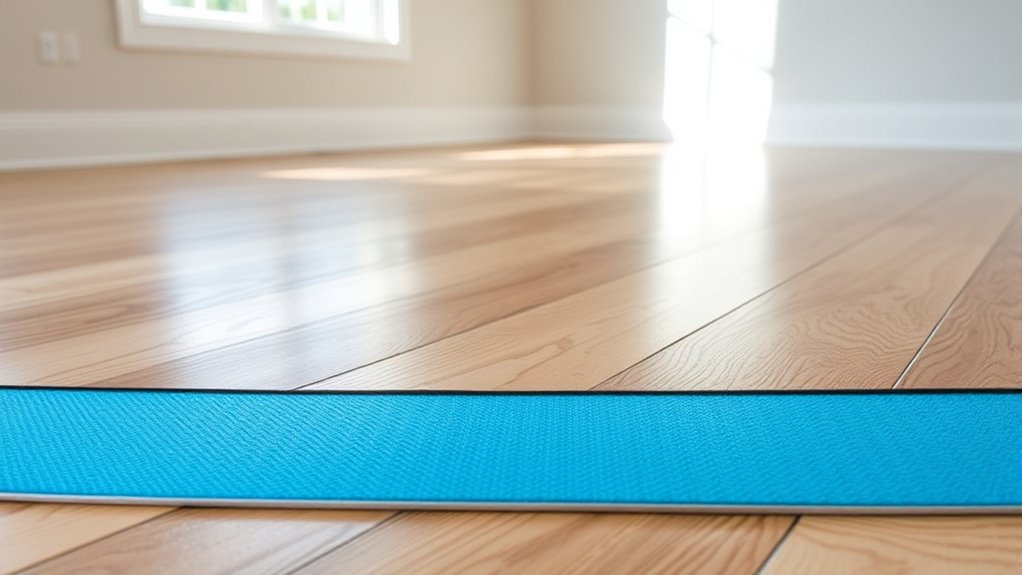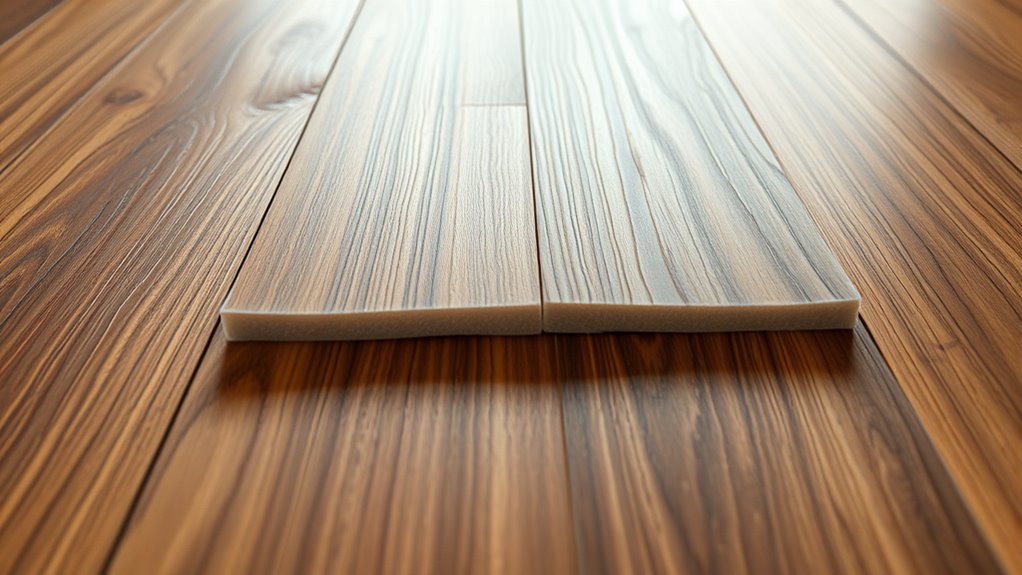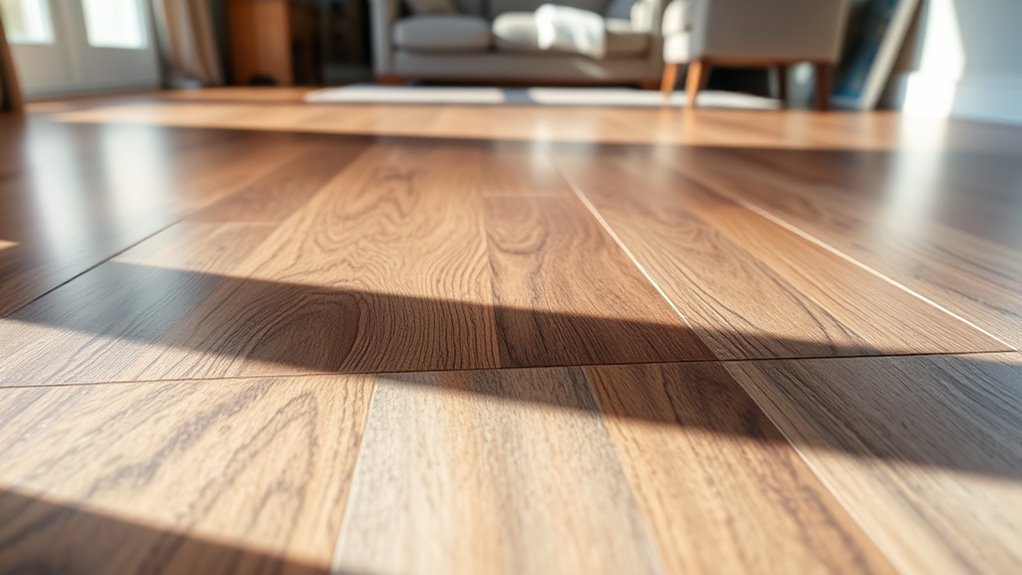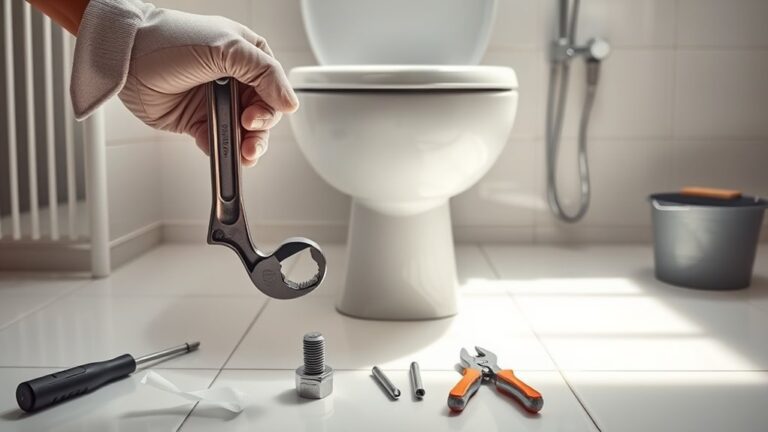You do need underlayment for laminate flooring to guarantee proper sound absorption, moisture protection, and floor stability—even if your laminate has built-in padding. Underlayment also compensates for minor subfloor imperfections, enhances thermal insulation, and helps prevent warping or damage. While it’s sometimes optional on perfectly flat, dry subfloors, using the right underlayment is key for performance and durability. Exploring the types and installation tips can help you choose the best option for your floor.
What Is Laminate Flooring Underlayment?

Laminate flooring underlayment is a thin layer of material installed between the subfloor and the laminate planks. When you consider underlayment installation, you’re adding a vital component that enhances performance and comfort. The underlayment benefits include sound absorption, moisture protection, and improved floor stability. By buffering minor subfloor imperfections, it guarantees a smoother, more durable surface. This layer also provides thermal insulation, contributing to energy efficiency and comfort underfoot. For anyone seeking the freedom to customize their space without compromise, underlayment installation is indispensable. It extends the lifespan of your flooring by mitigating damage caused by moisture and impact. Understanding these underlayment benefits empowers you to make informed decisions, guaranteeing your laminate flooring performs at its best while maintaining your desired level of comfort and durability.
Types of Underlayment for Laminate Flooring
Choosing the right underlayment is essential for optimizing your flooring’s performance and longevity. You’ll encounter several types designed to meet specific needs. Foam underlayment is common, offering basic thermal insulation and moderate acoustic performance, ideal for standard installations. For enhanced sound reduction, cork underlayment excels, absorbing impact noise while providing natural thermal insulation. Rubber underlayment presents superior acoustic performance and durability, suitable for high-traffic areas. Felt underlayment, often recycled fibers, balances moisture resistance with sound absorption and thermal properties. Additionally, some underlayments integrate moisture barriers to protect against subfloor dampness. When selecting, consider your specific environment’s requirements—thermal insulation needs, acoustic comfort, and subfloor conditions—to guarantee your laminate flooring performs freely and reliably over time.
Benefits of Using Underlayment

Understanding the various types of underlayment helps highlight the advantages they bring to your flooring system. When you install laminate flooring, underlayment serves essential functions beyond just a cushion. It enhances sound insulation, reducing noise transmission between floors, which is key for maintaining a peaceful environment. Thermal resistance provided by underlayment improves energy efficiency, keeping your space warmer or cooler as needed. Additionally, underlayment offers moisture protection, ensuring your laminate doesn’t warp or degrade over time. It also compensates for minor subfloor imperfections, creating a stable foundation for your flooring.
Key benefits include:
- Enhanced sound insulation for quieter living spaces
- Improved thermal resistance for better energy efficiency
- Moisture barrier to protect flooring integrity
- Smoothing out subfloor irregularities
- Increased overall floor durability and comfort
When Is Underlayment Necessary?
When should you use underlayment beneath your flooring? Underlayment necessity primarily depends on the subfloor type and your flooring’s performance requirements. If you’re installing laminate over concrete, underlayment is vital to provide moisture protection and improve flooring stability. Similarly, when working with uneven or plywood subfloors, underlayment helps create a smooth, level surface that prevents wear and noise. It also absorbs minor imperfections, reducing floor movement and enhancing comfort. If your laminate lacks built-in padding, underlayment becomes essential to maintain structural integrity and prolong life. However, on perfectly flat, dry, and stable subfloors, underlayment may be optional. Understanding these factors guarantees you maintain your flooring’s durability and freedom from future issues, making underlayment necessity a key consideration in your installation process.
Underlayment for Laminate With Built-In Padding

Although laminate flooring with built-in padding offers some level of cushioning and sound absorption, you still need to analyze whether additional underlayment is necessary based on your subfloor conditions and performance goals. The built-in benefits reduce installation complexity but might not address moisture barriers or uneven surfaces adequately. Consider these factors when evaluating padding options:
- Subfloor type and condition
- Moisture levels and vapor barriers
- Desired soundproofing efficiency
- Thermal insulation needs
- Load distribution and impact resistance
If your subfloor is concrete or uneven, or you need enhanced moisture protection and sound control beyond the built-in benefits, installing a separate underlayment can improve durability and comfort. Ultimately, the choice depends on your specific environment and performance expectations to guarantee ideal flooring longevity and satisfaction.
How to Choose the Right Underlayment
When choosing the right underlayment, you need to contemplate the material type, as options like foam, cork, and rubber each offer different benefits. Pay close attention to thickness and density, since these factors affect sound absorption, moisture resistance, and floor stability. Selecting the correct combination guarantees ideal performance and longevity for your laminate flooring.
Material Types Overview
Selecting the right underlayment for laminate flooring involves understanding the distinct material types available and their specific properties. Each type offers varying benefits regarding material durability, sound absorption, moisture resistance, and compatibility with installation methods. Knowing these will help you make an informed choice suited to your flooring needs.
Common underlayment materials include:
- Foam: Lightweight, easy to install, provides basic sound dampening.
- Cork: Durable, natural, excellent sound insulation and moisture resistance.
- Rubber: High durability, superior soundproofing, resists mold and mildew.
- Felt: Dense, enhances material durability, ideal for uneven subfloors.
- Combination: Multi-layered for enhanced performance, supports various installation methods.
Choosing the right material balances performance with your freedom to install efficiently and maintain long-term flooring integrity.
Thickness and Density Choices
Two key factors you’ll need to evaluate when choosing underlayment are thickness and density, as they directly impact sound absorption, moisture control, and floor stability. Thickness considerations typically range from 2mm to 6mm; thinner underlayments offer less cushioning but provide better stability for laminate floors, while thicker options enhance comfort and noise reduction but may affect floor height and door clearance. Density options influence durability and compression resistance—higher density underlayments resist indentations and provide long-term support, essential if you prioritize floor longevity and freedom from sagging. Balancing these factors depends on your subfloor type and usage patterns. Selecting the right thickness and density guarantees peak performance, letting you enjoy your laminate flooring without compromises on comfort, protection, or structural integrity.
Installation Tips for Underlayment
Properly installing laminate flooring underlayment is essential for guaranteeing durability and performance. To achieve a flawless underlayment installation, you’ll need the right underlayment tools and a clear process. Start by thoroughly cleaning and leveling the subfloor. Then, unroll the underlayment, guaranteeing seams align but don’t overlap. Secure the edges with tape designed for underlayment to prevent shifting.
Clean, level, and carefully align underlayment seams, securing edges to ensure a durable laminate floor installation.
Keep these tips in mind:
- Use a utility knife for precise cutting.
- Acclimate underlayment to room temperature before installation.
- Leave a small expansion gap around the perimeter.
- Avoid wrinkles or folds during placement.
- Guarantee vapor barriers are correctly positioned if required.
Following these steps guarantees stability, moisture protection, and sound absorption—key for a long-lasting laminate floor.
Common Mistakes to Avoid With Underlayment
You need to choose the correct underlayment thickness to guarantee proper support and flooring performance. Don’t overlook installing a moisture barrier, as it prevents damage from subfloor dampness. Also, skipping soundproof layers can lead to increased noise and reduced comfort in your living space.
Incorrect Thickness Choices
Although selecting underlayment thickness might seem straightforward, choosing an incorrect thickness can compromise the performance and durability of your laminate flooring. Using an underlayment that’s too thick or too thin often leads to issues from improper installation, affecting floor stability and comfort. To avoid these problems, consider the following:
- Excessively thick underlayment may cause locking mechanism failure.
- Too thin underlayment can result in insufficient sound absorption.
- Incorrect thickness might reduce underlayment’s moisture resistance.
- Uneven flooring height due to improper thickness affects changes.
- Warranty voidance from non-compliance with manufacturer specs.
Always match your underlayment thickness to your laminate flooring requirements and subfloor conditions. Doing so guarantees ideal resilience, soundproofing, and long-term performance without compromising your freedom to customize your space.
Overlooking Moisture Barriers
Since moisture can severely damage laminate flooring, neglecting to include an effective moisture barrier in your underlayment setup can lead to warping, mold growth, and structural failure. Proper moisture control is essential to protect the subfloor and laminate layers from water vapor that seeps up, especially in basements or over concrete slabs. Without this barrier, you compromise the flooring longevity, forcing premature replacement or costly repairs. When selecting underlayment, guarantee it incorporates a reliable vapor barrier or add a separate polyethylene sheet beneath. This prevents moisture migration, maintains dimensional stability, and safeguards the adhesive and core materials of your laminate. Overlooking this critical step restricts your flooring’s potential freedom to perform in varied environments, undermining durability and your investment’s lifespan.
Skipping Soundproof Layers
Beyond moisture protection, another common oversight when installing laminate flooring underlayment is neglecting soundproofing layers. Skipping soundproof layers compromises noise reduction, leading to increased footstep sounds and echo within your space. To maintain freedom from intrusive noise, consider these soundproofing options:
- Foam underlayment for basic sound dampening
- Cork layers for natural noise reduction and durability
- Rubber underlayment providing superior sound insulation
- Combination underlayments with moisture and soundproof barriers
- Specialized acoustic mats designed for maximum noise control
Choosing the right underlayment enhances comfort and privacy by minimizing sound transmission. Don’t sacrifice this critical layer; it’s essential for a quieter, more enjoyable environment beneath your laminate flooring.




